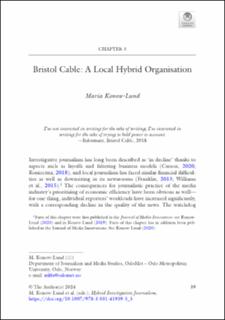| dc.description.abstract | Investigative journalism has long been described as ‘in decline’ thanks to aspects such as layoffs and faltering business models (Carson, 2020; Konieczna, 2018), and local journalism has faced similar financial difficulties as well as downsizing in its newsrooms (Franklin, 2013; Williams et al., 2015). The consequences for journalistic practice of the media industry’s prioritising of economic efficiency have been obvious as well—for one thing, individual reporters’ workloads have increased significantly, with a corresponding decline in the quality of the news. The watchdog function of local newsrooms—that is, their ‘democracy-enabling role’ of holding the powerful to account (Williams et al., 2015, p. 204)—has been undermined as well. The present study addresses the fact that, despite the persistence of what Rachel Howells (2015) calls ‘black holes’ in local news coverage, some of the most interesting entrepreneurial actors in UK investigative journalism have chosen the local market in which to establish themselves, including the two cases discussed below, Bristol Cable and the Bureau Local (our next chapter). Although we would argue that such recent start-ups remain under-investigated, some studies do exist (Konow-Lund, 2019, 2020, Birnbauer, 2019; Colbran, 2022; Konieczna, 2018; Price, 2017). Colbran, for example, focuses on ‘how the non-profits are challenging journalistic “norms” and expanding the Fourth Estate role of the investigative journalist’ (Colbran, 2022, p. 115). Here, we are interested in how these actors respond to their local contexts and construct their production practices in hybrid and innovative ways in relation to organisational structure as well as technology. Hybridisation is here understood as the blending of traditional practices with new methods within journalism, or, as Chadwick writes, what happens when ‘older and newer media logics in the field of media and politics blend, overlap, intermesh, and coevolve’ (2013, p. 4). | en_US |

